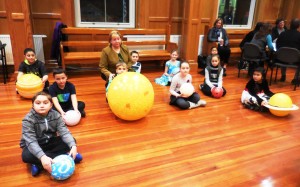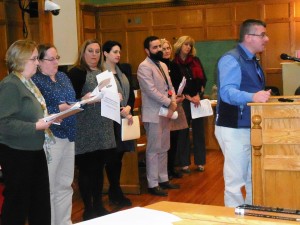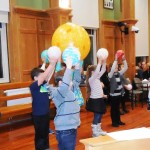WESTFIELD – Highland Elementary School’s third grade English language students, under teacher Yelena Alekseyevets, gave a presentation near the start of Monday’s School Committee meeting on the solar system. Using inflatable balls representing the sun and planets, each student talked about the properties of their planet, and its proximity to the sun. Three student narrators led them through the informative talk, including a demonstration of how the planets circled the sun as the students pirouetted around the room.

Third grade students from HIghland elementary school wait with their teacher Yelena Alekseyevets to give a presentation on the solar system to the School Committee on Monday.
The presentation was a good precursor to a report on the State of the Elementary Schools, given by all seven elementary school principals. The administrators tag-teamed their presentations, speaking about their own schools in particular, and then about district approaches to elementary education as a whole. The report demonstrated while the schools are different in size and populations, they are working together district-wide towards common goals.
For example, Mary Claire Manning, the principal of Highland Elementary School, said her school received seven new English language learners in one day in January, and three more the next day, with another three coming soon. She said almost 50% of the students in the school have English as a second language.
School Committee vice-chair Cynthia Sullivan asked whether some of the students would be returning to their home districts after receiving ELL training at Highland, making the point that not all the students assigned there upon arrival remain at Highland.
Cynthia Kennedy, the principal of Paper Mill, said her school also had an influx of five students in January. Paper Mill houses the CLEAR autism program. Kennedy said the percentage of high needs students in the school is growing.
Frances St. Peter-Sanft of Franklin Avenue Elementary School proudly said her school was ranked Level 1 by the state last year, and they are committed to staying on that trajectory as long as possible. She said the families in her neighborhood are getting poorer. She said the focus at their school is moving students up from proficient to advanced, and from needs improvement to proficient.
Salvatore Frieri, new principal of Munger Hill this year, said his school has the highest population of students with disabilities. He said they have maximum participation in chorus, drama and sports at his school. Frieri also spoke about a small group of students at the school who are unable to participate in MCAS, and instead are assessed on portfolios. He said that the school’s Level 3 status was in part due to incomplete assessments with this group, which he said will be corrected this year.

Superintendent Stefan Czaporowski and all seven elementary school principals presented to the School Committee on Monday.
“Showing their growth is the most important thing for all students,” Frieri said.
Alison Hamilton, principal of the Russell Elementary School, said her school is the smallest, and while the population has decreased, the percentage of students with high needs and economic disadvantage has increased. Her school is no longer a Title I school, based on the economic need of families, which has resulted in a loss of grant funding for some programs. She said they are holding steady.
Stacy Burgess, new principal of Abner Gibbs, said her school also has an increasing high needs population. She said the school is working with Adam Garand, administrator of special services, to incorporate the “universal design for learning” approach, which involves inclusive classrooms where students are working at their own levels.
Kathleen O’Donnell, the principal of the Southampton Road School, one of the larger schools with a population of 450, said they too have increased numbers in high needs and economically disadvantaged students. Southampton Road houses the QUEST program for students with autism who are high functioning. She said the school effectively uses data from math and literacy assessments to help all students achieve their potential. O’Donnell also said that every single room in the school is being used.
“We need a new school,” Sullivan said.
The principals also each spoke about different universal approaches across all of the elementary schools, including academic supports for students, enhanced technology in the classrooms, interventions to help students who are struggling, emphases on positive school climates, and parent and community engagement with the schools.
St. Peter said you can learn a lot about the climate of a school by visiting the school, and whether the students are well-behaved and friendly. “It’s important that staff and students feel wanted,” St. Peter said.
Hamilton stressed engagement with the community, saying “it still takes a village.” She said she has a group of grandparents raising their grandchildren. She also said the Boys & Girls Club before and after school programs have become important, noting that parents and families are very busy, making it hard to get parents more involved. She talked about a small core group of people who work very hard for the school.
“School has gotten very complicated. All of the schools are doing everything they can to make sure parents feel welcome,” Hamilton said,
“Seven years ago when I first started, the School Committee didn’t hear a lot of ‘we’ do this or that. It was very individualized. There are wonderful things that are happening in our elementary schools. I thank all of you for all the hours you put in, it is having an impact,” Sullivan said at the end of the presentation.
Westfield Public Schools Superintendent Stefan Czaporowski said in his seventh month, he feels the district is growing closer and stronger. In the second part of his Entry Plan presentation, which followed that of the elementary schools, he said the district is focusing on instruction, district lead teachers, curriculum renewal in science and social studies, professional development, and positive behavior interventions and support.
He said there is still a need for more science materials, and more technology in the schools.
Czaporowski said he also did an analysis of the district’s administrative costs, to see whether they were top heavy, as is sometimes said. He found that Westfield had the lowest and second lowest percentage of administrative spending among comparable districts in 2014 and 2015, and spent only half of the state-wide average on administration.
At the very start of Monday’s meeting, Mayor Brian P. Sullivan asked for a moment of silence for Ted Laborde, long-time newspaper reporter for The Republican who passed away on Sunday. Laborde covered the School Committee and City Council in town for decades, and was a friend and colleague to many in the room.


